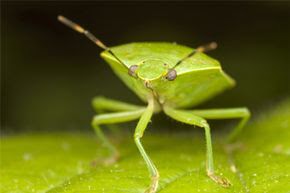Quck answer
There is no exact number, but it is estimated that there are around 1 million known species of insects and many more yet to be discovered. Insects make up more than half of all known living organisms on Earth and play a crucial role in many ecosystems. Despite their small size, they have a big impact on the world and are essential for pollination, decomposition, and as a food source for other animals. While some people may view bugs as pests, they are an important part of our natural world and should be appreciated for their unique adaptations and contributions to the planet.
Wild Animals

The green stink bug (Chinavia hilaris) is a member of the Heteroptera order, known as a “true bug.”
Clarence Holmes/Getty Images
Have you ever fled inside on a warm summer evening, escaping from a bug invasion? Although it may seem that flying or crawling creatures have forced you to seek refuge, don’t be too quick to label them all as “bugs”.
Strictly speaking, a bug is always an insect, but not all insects are bugs. Bugs belong to the insect order Heteroptera, commonly referred to as “true bugs.” Some of the well-known members of this order include stink bugs, squash bugs, water striders, and bed bugs.
The term “Heteroptera” comes from the Greek word which means “different wings,” describing one of the characteristics of true bugs. In simple terms, when at rest, the wings lie flat over the body of a bug and are partially or wholly constructed of membranes. Other characteristics of true bugs include an elongated mouthpiece called a labium, which is used for piercing and sucking, four or five-segmented antennae, and a prominent scutellum, a part of the insect’s body that is uniquely developed in Heteroptera.
Worldwide, over 42,000 bug species have been identified, with over 3,500 found in North America, both in water and on land. Many families exist within the Heteroptera classification, but the three most significant are Miridae (plant bugs), Lygaeidae (seed bugs), and Pentatomidae (stink bugs).
These bugs mostly live and feed on leaves, stems of plants, and the nutrients within seeds. Plant-feeding bugs are sometimes blamed for weakening plants because they suck out sap or cause localized injuries to stems or leaves. However, the damage they cause to plants is minimal in general.
Other land bugs scavenge in caves, the soil, or even ant nests. Some are predators, such as the assassin bug, which is common in Britain and known to prey on other insects.
Some bugs feed on human blood, such as the notorious bedbug. Bedbugs are parasites that derive sustenance from the bodies of birds or mammals, including humans. While bedbugs leave annoying bites, they are considered harmless and haven’t been linked to the transmission of disease.
Water bugs are another group of true bugs that live their entire lives on or under the surface of fresh or saltwater or along a shoreline. Examples include water scorpions (from the Nepidae family, a different species than a scorpion) or saucer bugs. Water bugs feed on plants and other aquatic organisms. Water bugs are often predators, and some can inflict a painful bite on humans.
Next time they send you running, whether they’re flying around your head or crawling up your leg, remember that only some of these creatures can be rightfully called “bugs,” even though they’re all bugging you like crazy.
Additional Information Available
Related Articles
- Overview of Insects
- Aquatic Bug
- Facts About Bedbugs
- The Ultimate Insect Quiz
- Introduction to Insects
Sources
- Amateur Entomologists’ Society. “Heteroptera.” (April 10, 2015)http://www.amentsoc.org/insects/fact-files/orders/hemiptera-heteroptera.html
- The Entomological Society of America. “Frequently Asked Questions.” (April 10, 2015) http://entsoc.org/resources/faq#triv1
- Livermore, L. “Introduction to Heteroptera.” March 6, 2012. (April 10, 2015) http://ihs.myspecies.info/content/introduction-heteroptera
- Meyer, John R. “Hemiptera Suborder Heteroptera.” April 8, 2009. (April 10, 2015) http://www.cals.ncsu.edu/course/ent425/library/compendium/heteroptera.html
- United States Environmental Protection Agency (EPA). “Introduction to Bed Bugs.” March 13, 2005. (April 10, 2015) http://www2.epa.gov/bedbugs/introduction-bed-bugs
FAQ
1. What is the estimated number of bug species in the world?
It is estimated that there are between 6 and 10 million species of insects in the world, which make up about 90% of all animal species on the planet. Among these, there are around 1 million species of bugs, which belong to the order Hemiptera.
2. How many species of bugs have been identified so far?
Currently, around 80,000 species of bugs have been identified and named by scientists. However, it is believed that there are many more species that have not yet been discovered or described.
3. What countries have the highest number of bug species?
The countries with the highest number of bug species are those with the most diverse ecosystems, such as tropical rainforests. Brazil, Indonesia, and Colombia are among the countries with the highest number of known bug species.
4. How many species of bed bugs are there?
There are around 90 species of bed bugs, although only a few of them are known to feed on humans. The most common species that is found in human habitats is Cimex lectularius.
5. How many species of stink bugs are there?
There are around 5,000 species of stink bugs, which are known for their ability to emit a foul odor as a defensive mechanism. These bugs belong to the family Pentatomidae.
6. How many species of assassin bugs are there?
There are around 7,000 species of assassin bugs, which are known for their predatory behavior and ability to inject venom into their prey. These bugs belong to the family Reduviidae.
7. How many species of shield bugs are there?
There are around 6,000 species of shield bugs, which are named for their shield-shaped bodies. These bugs belong to the family Acanthosomatidae.
8. How many species of water bugs are there?
There are around 5,000 species of water bugs, which are adapted to living in aquatic environments. These bugs belong to the order Hemiptera and are found in both freshwater and saltwater habitats.





Leave a Reply